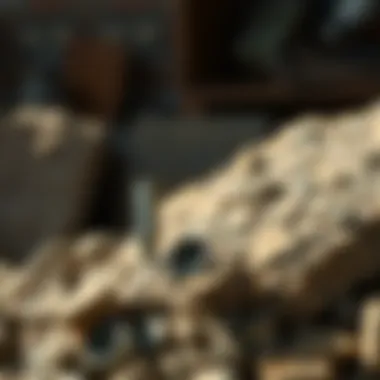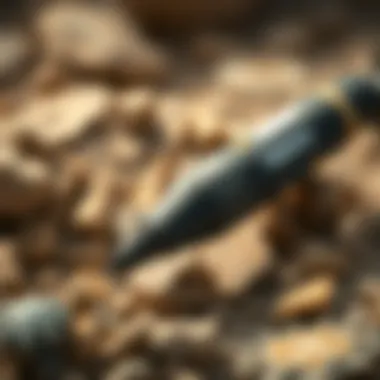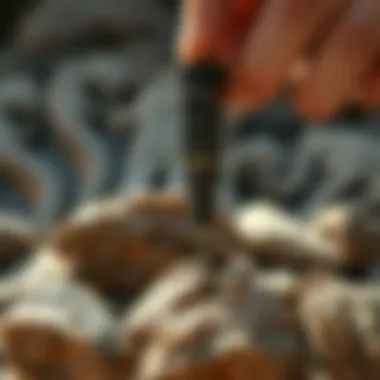Choosing the Best Dremel for Rock and Fossil Collecting


Intro
For rock and fossil collectors, choosing the right Dremel tool can be as thrilling as finding a rare specimen. It's not just about the specs; it’s about enhancing your passion and journey through geology. A Dremel isn’t just a tool; it's an extension of your hands as you chisel away at solid rock or polish that shimmering fossil. This guide explores how to select the ideal Dremel, tailored specifically for enthusiasts in both fields.
Rock and Fossil Identification
Types of Rocks and Fossils
Before delving into the features of Dremel tools, understanding what you might be working with is crucial. Rocks are generally classified into three main categories:
- Igneous Rocks: Formed from cooled magma, these include granite and basalt.
- Sedimentary Rocks: These result from sediment accumulation, like limestone and sandstone.
- Metamorphic Rocks: Rocks transformed by heat and pressure, such as schist or marble.
Fossils, on the other hand, are remnants of living organisms. They can be classified into:
- Body Fossils: Actual parts of the organism, like bones or teeth.
- Trace Fossils: Evidence of animal activity, like footprints or burrows.
Characteristics to Look For
When identifying rocks and fossils, look for unique features:
- Color: Variations can indicate different minerals.
- Texture: Smooth, rough, or layered surfaces can give clues about formation.
- Weight: Heavier specimens might suggest denser minerals.
- Patterns: Fossils often exhibit telltale patterns unique to their species.
Tools for Identification
A Dremel tool can make identification easier by allowing you to examine features up close. Complement it with basic tools like:
- Magnifying Glasses: For those tiny details.
- Field Guides: To help recognize various rocks and fossils.
- Hammer and Chisel: Essential for careful extraction.
Collecting Tips and Techniques
Best Practices for Collecting
Effective collecting requires more than just knowledge of geology. Always:
- Research Locations: Certain areas are more fruitful than others.
- Follow Laws: Ensure you have permission to collect, adhering to local regulations.
Locating Prime Collecting Sites
Some of the best places to find rocks and fossils include:
- Riverbeds: Erosion often exposes hidden gems.
- Construction Sites: You might stumble upon unique geological layers.
- Quarries: They often have a variety of exposed materials accessible for collecting.
How to Safely Extract Specimens
When it comes to extracting, safety is paramount. Use:
- Proper gear such as gloves and goggles.
- Tools like a Dremel for careful cutting without damaging your specimens.
Preservation and Display
Techniques for Preserving Rocks and Fossils
To ensure your finds remain intact:
- Seal them: Certain fossils benefit from a protective sealant that prevents deterioration.
- Store in a climate-controlled area: This prevents moisture damage.
Proper Storage Methods
A few storage methods are worth considering:
- Display Cases: These protect while highlighting your collection.
- Ziploc bags: Good for smaller specimens, keeping them dust-free.
Creative Display Ideas
Showcasing your treasures can be just as enjoyable as collecting them. Consider:
- Shadow boxes or glass display cases to create visual interest.
- Themed displays: Group specimens by type or origin for a curated look.
Geological Insights
Geological Formations and Processes


Understanding formations can enrich your collecting experience. Recognizing how tectonic movements create various rock types can give insights into their history. Books and resources like Britannica or local geological survey websites can enhance your knowledge.
Historical Significance of Rocks and Fossils
Each specimen has a story to tell. Fossils allow us an uncommon glimpse into earth's past, tracing back the evolution of life. These tales can often be connected to larger historical events, such as mass extinctions or the emergence of new species.
Notable Discoveries in the Field
Stay curious about what's being uncovered all around the world. Communities such as those on Reddit can provide real-time updates and discussions about remarkable finds.
By following this guide, you’re well-equipped to select the best Dremel tools for your rock and fossil collecting needs and to enjoy the journey of discovery that geology provides.
Understanding Dremel Tools
When it comes to the intricate process of rock and fossil collecting, having the right tools can make all the difference. This is where Dremel tools come into play. Understanding Dremel tools is fundamental for any serious collector looking to enhance their skills. These versatile rotary tools have carved a niche in the world of preparation and display of geological finds. They offer various speeds and attachments, allowing users to tackle specific tasks with finesse and precision.
What is a Dremel?
A Dremel is essentially a handheld rotary tool, nimble yet potent enough to handle a variety of tasks. It’s like a Swiss Army knife for hobbyists, combining an electric motor with a set of interchangeable bits. You can use it for cutting, grinding, polishing, even engraving. Its lightweight body is a bonus, making it suitable for long hours of work without tiring your hands too much.
Why should collectors care about Dremel tools? Because they simplify otherwise labor-intensive tasks—be it removing matrix from fossils or smoothing down rough edges on crystals. In short, a Dremel can help turn those rough rocks into eye-catching displays.
Common Uses in Rock and Fossil Collecting
Dremels find numerous applications in the field of rock and fossil collecting, each more specific than the last. Some of the most common uses include:
- Trimming and Shaping: When working with fossils, precision is key. Dremel tools enable collectors to trim and shape their specimens with a level of accuracy that hand tools just can’t match.
- Polishing: After preparing your specimen, polishing it to a shine can bring out colors and details hidden beneath the surface.
- Engraving and Detailing: Some collectors may want to engrave specific information directly onto their specimens for future reference or display.
- Cleaning: Dirt and debris can be a fossil’s worst enemy. Dremels are very nifty at cleaning off stubborn residues without damaging the specimen itself.
The beauty of it all? Each of these tasks can be achieved swiftly, allowing you to spend more time enjoying your finds.
Benefits of Using a Dremel
Using a Dremel in rock and fossil collecting comes with several compelling advantages:
- Efficiency: Traditional tools might take ages to accomplish the same tasks. A Dremel can significantly speed up the process, giving you more time to explore.
- Precision: The ability to adjust speed and use specific attachments makes it easier to work delicately on fragile specimens. You’re less likely to make mistakes that could ruin an irreplaceable find.
- Versatility: With the range of attachments available, one Dremel can assist in various tasks—be it cutting, sanding, or polishing—all in one handy tool.
- Portability: Most Dremel models are lightweight and easy to transport, perfect for on-site work or field trips.
"A well-chosen tool can be the difference between a laborious task and a joy."
It’s clear that getting acquainted with these tools is not just a choice; it’s an essential step towards becoming a more proficient collector.
Key Features to Consider
When embarking on the quest to find the most fitting Dremel tool for rock and fossil collecting, one must pay heed to certain key features that can significantly shape your experience. These tools are not merely gadgets; they can be the difference between a smooth operation and a frustrating endeavor. It’s crucial to dive into the specifics of power, versatility, ergonomic design, as well as the decision between battery life and corded options. This knowledge arms collectors, from beginners to seasoned rock hounds, with the insights needed to make a wise investment that aligns with their collecting habits and ambitions.
Power and Speed Settings
The power and speed settings of a Dremel can make all the difference, especially when working with various rock types and fossil materials. Different stones demand different amounts of power and speed. A soft mineral like talc requires less force compared to harder substances like quartz or granite. Understanding this spectrum is paramount.
Most modern Dremel tools offer adjustable speed settings, allowing users to dial in their preferred RPM (rotations per minute). This feature is beneficial as it helps prevent overheating or damaging delicate specimens. A range of 5,000 to 35,000 RPM is standard in many models, covering most needs.
- Soft Materials: Lower speeds can yield cleaner cuts.
- Hard Materials: Higher speeds assist in faster removal of material.
Being able to tweak the settings is like having a recipe card, ensuring you mix the right amount of ingredients for a successful project.
Versatility and Attachments
A Dremel's versatility can be illustrated by its attachments and accessories. This tool is not just a one-trick pony; it can handle a plethora of tasks. A standard rotary tool can be outfitted with various bits and attachments for grinding, cutting, sanding, or polishing. This adaptability is what makes the Dremel a favorite among collectors.
Here are some popular attachments:
- Carbide bits for carving and engraving.
- Diamond bits for grinding harder materials.
- Polishing pads for giving specimens that shiny finish.
Investing in a model that offers a wide range of compatible attachments allows you to experiment and adjust as your techniques evolve. You can think of it as gradually expanding your toolbox.
Ergonomic Design
A tool with a thoughtful ergonomic design can help prevent strain during long hours of use. Imagine handling your prized specimens while you’re constantly adjusting your grip or feeling discomfort in your hands. The right balance and grip shape is essential, especially when working with intricate details on small fossils. Look for Dremel models that feature a slim, comfortable grip that fits snugly in your hand. Rubberized handles can provide additional comfort and enhanced control, allowing you to work for extended periods without fatigue.
- Weight: A lighter tool can be easier to handle and manipulate.
- Stability: Look for a design that enables steady, responsive movements.
Battery Life vs. Corded Models
Choosing between a battery-operated or corded Dremel can feel like standing at a fork in the road. Each option comes with its own set of advantages and limitations. Corded models typically provide continuous power without the concern of depleting batteries mid-project, making them suitable for lengthy sessions or intensive work. This is especially pertinent when larger rock structures or tough minerals are involved.


Conversely, battery-powered models offer the flexibility of portability. If you’re a rock collector who enjoys fieldwork, a cordless option can be a game changer, allowing for easy movement between sites without tripping over cords. That said, it’s vital to assess the battery life. Most modern battery-operated Dremels provide decent longevity, often allowing for several hours of operation, but always ensure to check the specs.
Ultimately, consider your typical use cases. If you prefer the comfort of working in your garage, a corded model would serve you well, while regular excursions into the wild may call for the freedom of battery power.
The Best Dremel Models for Collectors
When it comes to choosing the right Dremel tools for rock and fossil collecting, understanding the models available is vital. Not only do these tools help shape and polish specimens, but they also elevate the collector's experience, transforming simple finds into polished treasures. Collectors of all levels, from novice enthusiasts to seasoned pros, need to know which Dremel models stand out and why. This section delves into several well-regarded options, each with unique advantages.
Dremel Series
The Dremel 4000 series is often lauded for its combination of power and versatility. With a robust motor and variable speed control, it delivers the necessary performance for intricate tasks like polishing delicate fossils or sharpening rock edges.
A standout feature is the integrated electronic feedback system, which maintains speed under load, ensuring consistent results, especially when working on tougher materials.
Key features of the Dremel include:
- Variable speeds: Ranging from 5,000 to 35,000 RPM, it gives you flexibility for different tasks.
- Versatile attachments: Compatible with over 150 accessories, perfect for various applications.
- Ergonomic grip: Designed for comfort during extended use.
This model's ability to handle a multitude of projects makes it a favorite among collectors who value precision and adaptability.
Dremel Series
If you’re looking for mobility, the Dremel 8220 series is a solid choice. This cordless model offers the independence of battery power without sacrificing the high-performance functions. Collectors often favor this version for its flexibility in fieldwork, allowing for on-the-go adjustments and modifications.
Notable aspects of the Dremel 8220 include:
- Cordless convenience: The freedom to operate anywhere, without being tethered to a power outlet.
- Speed options: Similar to the 4000 series, it ranges from 5,000 to 35,000 RPM.
- Lithium-ion battery: This extends the tool’s lifespan and ensures longer working intervals.
While some collectors might shy away due to battery considerations, the Dremel 8220 series offers unmatched versatility for outdoor excursions.
Dremel Lite
The Dremel Lite is an excellent entry-point model for beginners. While it may not have all the bells and whistles of the high-end models, it still packs a punch for smaller tasks and casual collectors. With a more straightforward approach, it's user-friendly and less intimidating for those new to the craft.
Some highlights of the Dremel Lite include:
- Lightweight design: Easy to handle, making it perfect for those just starting.
- 3,000 - 15,000 RPM range: Adequate for lighter tasks like engraving or light polishing.
- Cost-effective: This model is more budget-friendly, making it accessible for newcomers.
While it may not cater to heavy-duty tasks, the Dremel Lite is undoubtedly sufficient for collectors just starting in the field or those needing a straightforward alternative.
Dremel Series
The Dremel 3000 series rounds out the top models, offering a balance between affordability and performance. This series is often recognized for its reliability and effectiveness for general use, whether it’s for light hobby work or more engaged fossil preparation.
Features of the Dremel 3000 include:
- Universal power system: Compatible with most Dremel attachments and accessories.
- Variable speed control: Predator mode: 5,000 to 32,000 RPM, tailored to specific needs.
- Compact size: It’s lightweight yet powerful enough for most tasks.
Ultimately, the Dremel 3000 series serves as a great all-around tool, appealing to collectors who want an effective workhorse without breaking the bank.
Each of these models provides unique benefits. Evaluating your specific needs—whether it be the power of the 4000 series, the portability of the 8220, simplicity of the Lite, or the reliability of the 3000—will guide you to the right choice. Understanding these distinctions can enhance your collecting endeavors and improve your overall experience.
Comparative Analysis of Dremel Models
As rock and fossil collectors embark on their journey, the right tools can make all the difference. Analyzing various Dremel models available on the market is essential in making an informed choice. This section elaborates on aspects such as performance, cost-effectiveness, and real user experiences, helping collectors find the Dremel that suits their specific needs and budget.
Performance Evaluation
When we talk about performance, it really boils down to how effectively a Dremel can handle the tasks at hand. Different models come with distinct features that enhance their usability in rock and fossil collecting.
- Power Capability: A model equipped with a stronger motor not only performs tasks faster but also handles tougher materials seamlessly. For instance, a Dremel with a 175-watt motor might quickly grind fossils, while a less powerful option struggles or takes longer.
- Speed Control: Collectors often require precision, especially when dealing with delicate specimens. Models offering variable speed settings allow users to fine-tune their approach, ensuring that tasks like polishing are done without damaging the surfaces.
Maintenance of Dremel Tools
Maintaining your Dremel tool is essential not just for functionality but also for extending its lifespan. Just like a prized guitar needs tuning and care to play beautifully, a Dremel requires attention too. Regular maintenance can prevent potential issues and ensure that your tool performs at its best when you're out collecting rocks or fossils. A little elbow grease can save you from bigger headaches down the line.
Cleaning and Care
Cleaning your Dremel is straightforward but often overlooked. After a day spent chiseling through sedimentary layers, it’s crucial to remove dust and debris. Use a soft brush or a can of compressed air to clear out the crevasses where grit can accumulate. Make it a habit to clean the tool right after use.
Sometimes, you might face build-up from resins or adhesives. For that, a simple solution of warm, soapy water can work wonders. Just ensure to dry the tool completely before storage. Dust and moisture can be your worst enemies, causing rust or equipment failure. Keeping everything spick and span allows your Dremel to perform without hiccups.


Replacing Attachments
Attachments are the unsung heroes of the Dremel experience. They can make or break your rock and fossil projects. Over time, attachments can wear out or become less effective. Knowing when to replace them is key. If you notice your bit isn't cutting as effectively as before, it might need swapping out. Replacement is often straightforward, but one has to ensure that the new attachment is compatible with your specific Dremel model.
Also, don’t hesitate to explore new attachments that can expand your creative possibilities. Whether you are polishing a fossil or engraving details on a rock specimen, having the right attachment can transform a mundane task into an art form.
Troubleshooting Common Issues
Even the best Dremel tools encounter issues from time to time. It’s all part of the game. If your Dremel isn't spinning, first check if the power source is intact. Sometimes, a simple recharge or an outlet check can solve the mystery. If your tool is making unusual noises, it might indicate that debris has lodged in the motor.
Another common issue is overheating. This can happen if you are using the tool for extended periods. To avoid this, take breaks during use, which can help keep the tool cool and functioning properly. In short, detecting the problem early can save your tool from irreversible damage, allowing many more fossil-hunting adventures to come.
"Regular maintenance is not just about fixing problems. It's about preventing them."
By incorporating proper cleaning, timely replacement of attachments, and vigilant troubleshooting into your routine, you’ll enhance both the performance and lifespan of your Dremel. A well-maintained tool can make all the difference between a frustrating day in the field and a successful collecting experience.
Safety Considerations
When diving into the realm of rock and fossil collecting with a Dremel tool, safety should always take precedence. The nature of this hobby, while incredibly rewarding, comes with a few risks that can be mitigated through proper precautions. Having an awareness of these safety considerations helps protect not only your well-being but also the integrity of your collecting experience. Choosing the right protective gear and applying safe operating practices forms the cornerstone of a secure workflow. Refraining from overlooking these factors can minimize accidents and ensure a fruitful journey through the geological wonders.
Protective Gear
Equipping yourself with the appropriate protective gear is just as essential as selecting the ideal Dremel. Among the first lines of defense are safety goggles, which shield your eyes from flying debris. Rocks can break unexpectedly, sending shards flying your way; lack of eye protection could lead to serious injury. Not only that, but wearing a dust mask is advisable to avoid inhaling harmful particles generated during cutting or grinding processes, especially when working with softer stones that might produce fine, abrasive dust.
A sturdy pair of gloves is another must. Dremels have attachments that can get hot, and handling tools without the right gloves can lead to burns or cuts. Ensure your gloves are form-fitting yet durable, allowing you to maintain dexterity while providing a barrier against the tools and materials you will be working with.
Safe Operating Practices
In addition to protective gear, adhering to safe operating practices can significantly decrease the likelihood of accidents and injuries. Familiarizing yourself with the Dremel tool is paramount. Before you even plug it in, read the user manual as though it's a secret scroll revealing your next adventure. The manual contains essential information about speed settings and recommended attachments for different applications.
Here are a few tips to help keep you safe while operating your Dremel:
- Secure Your Workspace: Make sure your work area is clean and organized, free from clutter that might become a tripping hazard. This applies to the surface you'll be working on. If it's unsteady, you could be setting yourself up for trouble.
- Check Your Tools: Regularly inspect your Dremel and its attachments for wear and tear. A malfunctioning or damaged tool can easily lead to accidents. If something doesn't seem right, pause and assess before continuing.
- Maintain a Firm Grip: Keeping a steady hand while using the tool will enable you to exercise control. Practicing on scrap materials before working on your prized pieces helps build skill and confidence.
- Unplug When Changing Accessories: This might seem like a no-brainer, but so many mishaps happen when people try to change bits on a plugged-in tool. Always remember to disconnect it first to avoid accidental activation.
"Safety isn’t just about what you wear; it’s about how you act and prepare. Always plan ahead."
Ultimately, the goal of these safety considerations is to create a secure environment where you can explore the wonders of geology while minimizing risks. With the right gear and practices in place, you will enhance not only your collecting experience but also the longevity of your valuable Dremel tools. Discovering the history embedded in rocks and fossils can be immensely satisfying, and being safe ensures you can continue this pursuit well into the future.
Applications in Geological Preservation
When embarking on rock and fossil collecting, the judicious use of tools opens a world of possibilities for enthusiasts looking to preserve these natural treasures. Dremel tools play a critical role in geological preservation, enabling collectors to refine their specimens and highlight their unique features for display or study. Understanding their applications not only enhances the aesthetics of these natural artifacts but also contributes to their longevity.
The significance of using a Dremel tool in this context cannot be overstated. With appropriate speed and attachments, collectors can shape surfaces, smooth edges, and polish rocks or fossils with precision. Protecting the integrity of specimens while maintaining their natural beauty is a delicate balance, making the application of Dremel tools invaluable for both hobbyists and professionals alike.
Shaping and Polishing Specimens
One of the most notable applications of a Dremel in geological preservation is the shaping and polishing of specimens. Whether you handle rough stones from your last hunt or delicate fossils, a Dremel helps craft these materials into stunning visual displays. The encapsulation of fossilized creatures or intricate mineral formations can greatly benefit from careful shaping. Using a burr bit or a grinding wheel attachment, it’s possible to refine edges and contours, allowing the unique characteristics of each specimen to shine through.
Here are a few key aspects to consider:
- Precision: Dremel tools offer variable speed control, allowing users to adapt to different material hardness levels. This ensures that softer stones or fossils are treated with care, avoiding damage while achieving a smooth finish.
- Versatility: With an array of attachments, collectors can switch between grinding, sanding, and polishing, depending on their needs. This flexibility makes Dremel tools a one-stop-shop for enhancing various specimen types.
- Enhanced Aesthetics: Whether preparing specimens for personal collections or displaying them scientifically, the polished look significantly elevates the visual appeal, showcasing the beauty embedded in each piece.
Creating Displays for Collectors
Another essential application of Dremel tools lies in creating eye-catching displays for rock and fossil collections. The importance of presentation should not be underplayed; effectively displayed specimens can spark curiosity and educate viewers about geological history and diversity.
Dremel tools facilitate the crafting of custom bases or holders, accentuating your collection's beauty. Here’s what to keep in mind:
- Customization: A Dremel enables collectors to tailor display stands or cases specifically to fit their specimens, ensuring stability and aesthetics. Cutting and shaping wooden or acrylic bases makes it easy to create a cohesive look that enhances the overall appeal of the collection.
- Protective Measures: By using a Dremel to polish the surfaces of the specimens or their display cases, you can create a protective layer against dust and natural wear. This is crucial for maintaining the quality of your collection over time in an ever-changing environment.
- Informative Labels: Adding engraved labels or tags with a Dremel can bring an extra layer of depth to your displays, providing essential information like the specimen name, origin, or unique features. This not only educates viewers but also enriches the collecting experience for the owner.
By leveraging Dremel tools effectively, collectors can significantly impact their rock and fossil collections' visual appeal and preservation. The art of shaping, polishing, and displaying specimens enhances not only individual pieces but also the entire narrative of geological exploration and appreciation. For those serious about their collections, these applications are not mere conveniences but rather pivotal to the tasks of both preservation and presentation.
Culmination
Selecting the right Dremel tool for rock and fossil collecting is not merely a matter of convenience; it plays a significant role in the overall experience and success of your collecting endeavors. The insights gleaned throughout this article illuminate how these tools can enhance both the preservation and presentation of geological specimens.
To wrap things up, the critical elements of Dremel tools discussed are their power, versatility, and ergonomic design. When you dive into the world of rock and fossil collecting, having a tool that can adapt to different materials and tasks can mean the difference between a mere collection and a curated exhibit. For instance, a Dremel that offers various speed settings allows you to handle softer materials carefully while tackling harder rocks with more vigor. This adaptability is essential for collectors seeking to present their finds as bushels of history rather than mere rocks.
Moreover, consideration of user-friendly features can't be overstated. An ergonomic design translates into longer working hours without discomfort, ensuring that you can thoroughly engage in your passion. Whether you're shaping delicate fossils or polishing beautiful gemstones, a comfortable grip can keep your focus sharp.
Beyond functionality, every Dremel tool serves as an extension of your vision as a collector. The ability to preserve your specimens beautifully impacts not just aesthetic appeal but also their educational value. The link between the tools you choose and the quality of your work is undeniable. When the pieces of the puzzle fit well, your collection doesn't just sit; it breathes life, showcasing the wonders of our planet.
Finally, as we close this discussion, remember that knowledge is empowerment. By understanding what to look for in a Dremel, you set yourself up for success in the thrilling quest of geological collecting. With the right tool in your hands, you're not just collecting; you're telling a story that connects past and present.
Final Thoughts on Selecting a Dremel
Choosing the ideal Dremel requires careful consideration of both personal needs and project requirements. Start by assessing what types of rocks and fossils interest you most, as this will guide your tool selection. If your focus is on fine details and delicate pieces, a lightweight model with adjustable speed options is key. On the other hand, if you're working with robust gemstones, lean towards models renowned for their power and durability.
Additionally, explore user reviews from fellow collectors on platforms like Reddit or Facebook, which can provide real-world insights into each model’s performance. Don't shy away from seeking recommendations; the experiences of others can shed light on what works best in various scenarios. In your quest for the ideal Dremel, balancing functionality, comfort, and price will lead you to a tool that feels right in your hands. Remember—every great collection begins with a single, well-chosen tool.







